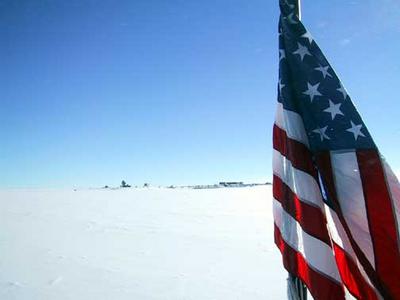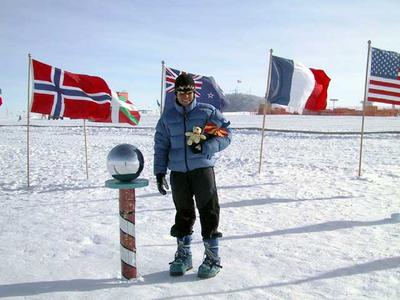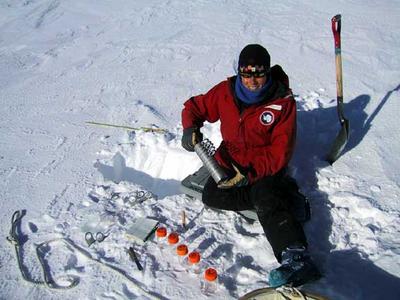6 January, 2003
Return to Springtime
Date: 01/06/02
Latitude: 77° 51’ S
Longitude: 166° 40’ E
Time of weather observation: 5:00 pm
Temperature: +2 C / +36F
Wind speed: 5 knots
Wind Chill: -01 C / +31 F
Wind Direction: Northwesterly
Meters of ice collected: 920
Log by Dan Dixon and Betsy Youngman
Who would have thought that we would ever have called the weather in
Antarctica warm? However, that was the first word that came to mind as
Markus, Andrea, Gordon and Betsy stepped off the plane from the South
Pole and on to the runway here at McMurdo Station yesterday afternoon.
The air felt so warm and mild, the snow was damp underfoot and one
didn’t even need a hat or gloves for the first time in two months. It
is a marvelous feeling to have shed a few layers of clothing. Summer
has arrived here on the coast of Antarctica, what a change it is from
the conditions at the South Pole! I even have seen little rivulets of
water running off the hillsides and down the streets. There is a smell
of summer mud in the air.
The conditions at the South Pole were severe in comparison, although
relatively mild compared to the norm. The coldest temperature we
experienced during our brief stay there was about -28 C and the winds
never rose much above 10 knots.
Dan, Susan, Paul, Mark, Carl and Lynn are still at Pole. They were
treated to a tour of the new Pole Station. The new South Pole Station
is still under construction; there are multitudes of temporary housing
huts erected nearby to house all the workers involved. There are also
hundreds and hundreds of meters of cargo and building materials staged
around the construction site, the whole area seems like an industrial
business area. During the tour we were informed that by the time the
new station was finished the whole area would be cleared leaving only
the Dome, the Arches, and the new station (along with the existing
science buildings). It wasn’t until we actually walked around inside
the new station that we really grasped its sheer size, it really is
enormous. There are still several parts of the building yet to be
added, by the time it is finished it will be almost double its present
size. Only a small part of the building was finished and furnished, the
rest was composed of huge metal girders, bare steel pipework, and
kilometers of wiring. It was quite a spectacle to see the workers
inside milling around like ants, trying to complete their construction
deadlines. Part of the new station is due to have winter-over staff
staying in it at the end of this summer season. The huge building on
the surface is only a part of the construction effort. Underground,
there are several huge arches housing all the essential facilities. One
of the most important new buildings is the new fuel arch, this has to
be large as fuel is arguably the most valuable resource on station. A
new power plant with several giant V12 CAT engine generators roars away
producing all the power needs for the station, the room itself looks as
if it is composed entirely of shiny steel pipes of all shapes and
sizes. There is a brand new heavy shop for fixing the heavy equipment
and machinery around the base (and believe me, there is a lot of it).
The old heavy shop has been turned into a gym and storage area. There
are new water supplies and sewage disposal facilities. One of the most
unusual things we were shown was the network of underground tunnels.
These tunnels are carved out of the snow and are the utility conduits
for essential pipework and wiring, it was very eerie standing in there
surrounded by cold white walls and looking at the pipes and wires
disappearing off into the distance.
All in all, our stay at the South Pole has been a most enjoyable one.
We were provided with all the facilities we could possibly need;
showers, washing, tools, and as much hot food as we could eat. It was a
perfect welcome for weary travelers. The staff and workers at Pole were
constantly helpful and always had a friendly smile; we look forward to
returning there again someday.
Each section of the ITASE team is putting the finishing touches on
their field season. For Markus and Betsy that means melting our snow
samples in order to analyze them for the same trace chemicals that we
were detecting in the atmosphere during the traverse. We have set the
detectors up in the warm and spacious Carry lab. The snow samples were
collected at each site, using a custom-made snow-sampling device. This
small metal coring instrument allows us to collect samples every two
centimeters as we push it into the snow. At each of the five sites that
we visited in the last two months we collected samples to a depth of
between thirty and fifty centimeters. Sampling to this depth, usually
the amount of snow that would collect in one to three years time,
allows understand the photochemical processes that snow undergoes
before it is buried and compacted becoming part of the ice sheet.
Once collected, the snow samples are carefully stored in sealed glass
bottles and transported and stored frozen. Right now, we have several
hundred of these small bottles stored in a freezer across the hall from
our chemical lab. Ironically, the freezer temperature is -25 C, just
the temperature that it was at South Pole when we left! If I miss the
intensity of the cold I know where to go find it.
Once the snow samples have been melted and analyzed we will begin to
pack and organize ourselves for the journey homeward. It is great to be
in the final phase of this adventure. Each of us is looking forward to
a chance to relax and to see loved ones at home and to defrost a bit
from the cold.

A view of Amundson - Scott South Pole Station from the roof hatch of the Blue Room.

Andrea, Betsy and Susan share a laugh.

Betsy and friend at the Ceremonial South Pole.

Betsy sits in the navigator's seat on the return flight from Pole to McMurdo.

Betsy working on snow sampling.
Contact the TEA in the field at
.
If you cannot connect through your browser, copy the
TEA's e-mail address in the "To:" line of
your favorite e-mail package.
|
